Time Travel Trail
1) Inauguration and First Observations (1971)

The first station represents the inauguration of the radio telescope after about three years of construction on May 12, 1971. Already on April 23, the supernova remnant HB21 was observed as the first successful measurement ("First Light") with the Effelsberg radio telescope.
From this point we have to cover a total distance of 50 years (5 km) to the last station of the trail.
2) Full Operations and First Pulsar Observations (1972)
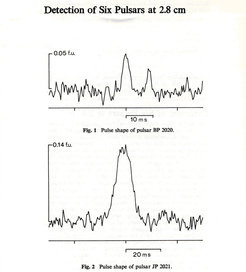
On August 1, 1972, the Effelsberg radio telescope and its receiver systems were put into full operation. In the same year, first pulsar measurements were made at a wavelength of 2.8 cm, which was the shortest wavelength used for pulsar observations to this time.
One year (100 m) has been covered from the start; 49 years (4.9 km) remain to the finish.
3) First Intercontinental VLBI Experiments (1973)
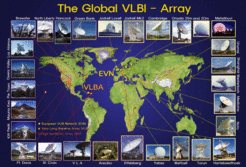
The Effelsberg radio telescope was integrated into a worldwide network of radio telescopes ("Very Long Baseline Inferometry", VLBI) at a very early stage. In 1973, the first measurements with transatlantic baselines took place, enabled by the connection of the 100m telescope with radio telescopes in the U.S.
Two years (200 m) have been covered from the start; 48 years (4.8 km) remain to the finish.
4) German Solar Probe HELIOS & Andromeda Galaxy (1974)

In 1974, the Effelsberg radio telescope was used as a receiving station for the HELIOS solar probe for six months during daytime. HELIOS was the first major project of German spaceflight. In the same year, the first complete map of the radio emission of the Andromeda galaxy M31 at 11 cm wavelength was published.
Three years (300 m) have been covered from the start; 47 years (4.7 km) remain to the finish.
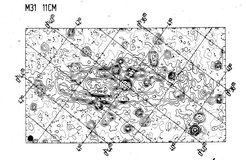
5) Water and Ammonia in External Galaxies (1977/79)

Due to its high sensitivity, the Effelsberg radio telescope is ideally suited for measurements of extremely weak radio signals. Though, spectral lines of water H2O (1977 in M33) and ammonia NH3 (1979 in IC342) could be detected for the first time in other galaxies several million light-years away.
Seven years (700 m) have been covered from the start; 43 years (4.3 km) remain to the finish.
6) Radio Map of the Complete Sky (1982)

After about ten years of measurements with the three largest radio telescopes on earth at that time (Effelsberg: 100 m, Jodrell Bank: 76 m, Parkes: 64 m diameter), the most accurate map of the radio emission of the complete sky at 73 cm wavelength was published in 1982.
11 years (1100 m) have been covered from the start; 39 years (3.9 km) remain to the finish.
7) Ammonia as Cosmic Thermometer (1983)
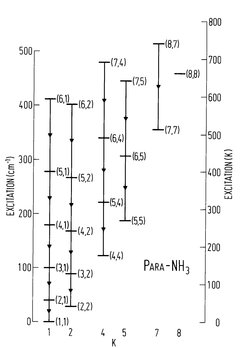
Observations of a whole range of spectroscopic lines of the ammonia molecule NH3 with the Effelsberg radio telescope led to the introduction of a cosmic thermometer to derive the temperature of molecular clouds.
12 years (1100 m) have been covered from the start; 38 years (3.8 km) remain to the finish.
8) Intraday Variability of Cosmic Radio Sources (1987)

The Effelsberg radio telescope was used to discover the short-term variability of extragalactic radio sources. In the central regions of extremely distant active galaxies (e.g. 0917+624, nine billion light-years away), one finds brightness variations within a few hours and can thus detect structures as small as the size of our solar system.
16 years (1600 m) have been covered from the start; 34 years (3.4 km) remain to the finish.
9) Zeeman Effect and Cosmic Magnetic Fields (1989)
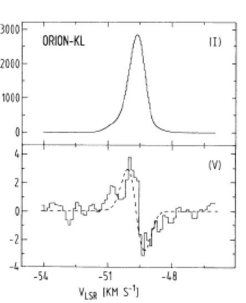
The Zeeman effect is the splitting of spectral lines in magnetic fields (Nobel Prize for Pieter Zeeman 1902). The verification of this effect in space was first demonstrated with the radio telescope Effelsberg for the water molecule H2O. This enables the investigation of magnetic fields in molecular clouds.
18 years (1800 m) have been covered from the start; 32 years (3.2 km) remain to the finish.
10) Full Replacement of Azimuthal Rail (1996)

A circular rail of 64 m diameter carries the complete weight of the Effelsberg radio telescope. After 25 years of operation, this rail had to be completely replaced. For this purpose, the telescope with its total weight of 3200 tons had to be "jacked up" for the time of the rail replacement.
25 years (2500 m) have been covered from the start; 25 years (2.5 km) remain to the finish.
11) Orbital Elements and Precession of Pulsar 1913+16 (1998)
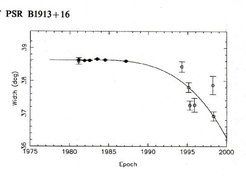
Einstein's general theory of relativity predicts a continuous change in the direction of a pulsar's rotation axis (geodetic precession) when it moves in the gravitational field of a companion star. With the Effelsberg radio telescope, this effect could be proven for the first time in case of the pulsar PSR 1913+16.
27 years (2700 m) have been covered from the start; 23 years (2.3 km) remain to the finish.
12) Magnetic Field of the Andromeda Galaxy (2003)
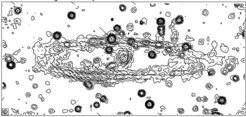
The systematic study of the magnetic fields of galaxies and of our Milky Way was started by observations of polarized radio emission with the Effelsberg radio telescope. A nice example is presented in a detailed map to study the magnetic field of our neighbour galaxy M31 at 6 cm wavelength.
32 years (3200 m) have been covered from the start; 18 years (1.8 km) remain to the finish.
13) New Subreflector (2006)

The subreflector of the Effelsberg radio telescope with a diameter of 6.50 m is located near the focal point at the tip of the four support legs. On October 5, 2006, a new, improved mirror with 100 motor-controlled active surface elements was installed, further increasing the performance of the radio telescope.
35 years (3500 m) have been covered from the start; 15 years (1.5 km) remain to the finish.
14) LOFAR Station Effelsberg (2007)
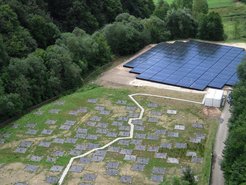
The first German station of the European low-frequency radio telescope LOFAR was built at the site of the Effelsberg Radio Observatory. LOFAR stations are distributed over several countries in Europe and are directly connected via fast data line connections.
36 years (3600 m) have been covered from the start; 14 years (1.4 km) remain to the finish.
15) First Millisecond Pulsar in Effelsberg (2010)

Special measurement programs to find new pulsars are running at the Effelsberg radio telescope. PSR J1745+10 is the first millisecond pulsar discovered at Effelsberg. It is a so-called "black widow pulsar", where the pulsar's high-energy radiation is almost completely vaporizing its partner over time.
39 years (3900 m) have been covered from the start; 11 years (1.1 km) remain to the finish.
16) Magnetar in the Galactic Centre (2013)
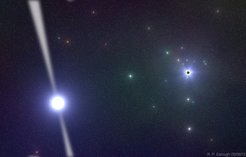
A pulsar with an extremely strong magnetic field, a so-called magnetar, was detected with the Effelsberg radio telescope in the immediate vicinity of the center of the Milky Way. It moves in an orbital period of about 500 years around the supermassive black hole in the centre (Sgr A* with more than 4 million solar masses).
42 years (4200 m) have been covered from the start; 8 years (800 m) remain to the finish.
17) Map of the Northern Sky in Neutral Hydrogen (2015)

Within the project "Effelsberg-Bonn-HI-Survey" (EBHIS), the complete northern sky was observed in the light of the 21-cm spectral line of neutral hydrogen (HI) with the radio telescope Effelsberg.
44 years (4400 m) have been covered from the start; 6 years (600 m) remain to the finish.
18) World Record: 11 Microarcseconds (2017)

Studying the spectral lines of water masers in the galaxy NGC 4258 in a Space-VLBI network connecting the RadioAstron space telescope with a number of Earth-based radio telescopes including the 100-m telescope, the highest angular resolution in astronomy with 11 microarcseconds only could be achieved.
46 years (4600 m) have been covered from the start; 4 years (400 m) remain to the finish.

19) GMVA: Deep in the Heart of Galaxies (2019)

The "Global Millimeter VLBI Array" (GMVA) is used to investigate details within the central regions of galaxies like Perseus A, Cygnus A, M87 and Sgr A* (center of the Milky Way) at very high angular resolution. At a wavelength of 3.5 mm only, the partizipating 100-m radio Effelsberg is pushed to its limits.
48 years (4800 m) have been covered from the start; 2 years (200 m) remain to the finish.
20) 50 Years Radio Telescope Effelsberg (2021)
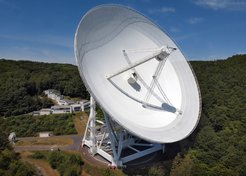
In 2021, the Effelsberg radio telescope has completed the first 50 years of its life. To mark the occasion, the German postal service issued an anniversary stamp “50 Jahre 100m-Radioteleskop Effelsberg”. Observations and research programs with the 100-m telescope will be continued.
After a total of 50 years corresponding to a distance of 5 km, the final station of the Time Travel Trail has been reached. The zig-zag path leads back to the starting point at the visitor pavilion.
This page was originally compiled as "Anniversary Trail" for the 40th anniversary of the 100m radio telescope with 14 stations ranging from 1971 to 2011 (Student internship by Frederick Emde, Elisabeth-von-Thüringen-Gymnasium, Cologne-Lindenthal). In its final version called Time Travel Trail, it now includes 20 stations from the 50-year history of the Effelsberg radio telescope between 1971 and 2021 and has been opened on the occasion of the 50th anniversary of the 100-m radio telescope in May 2021.





















